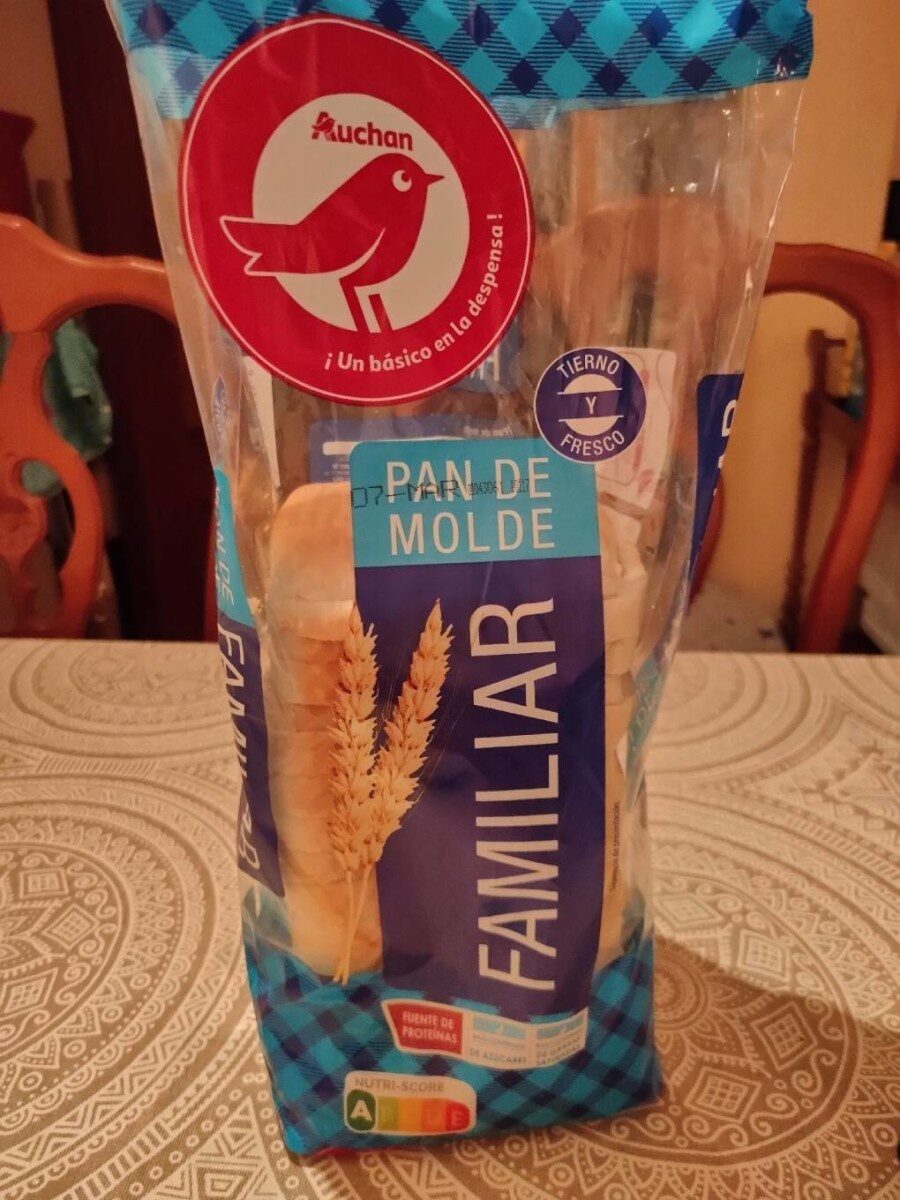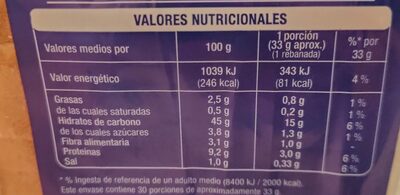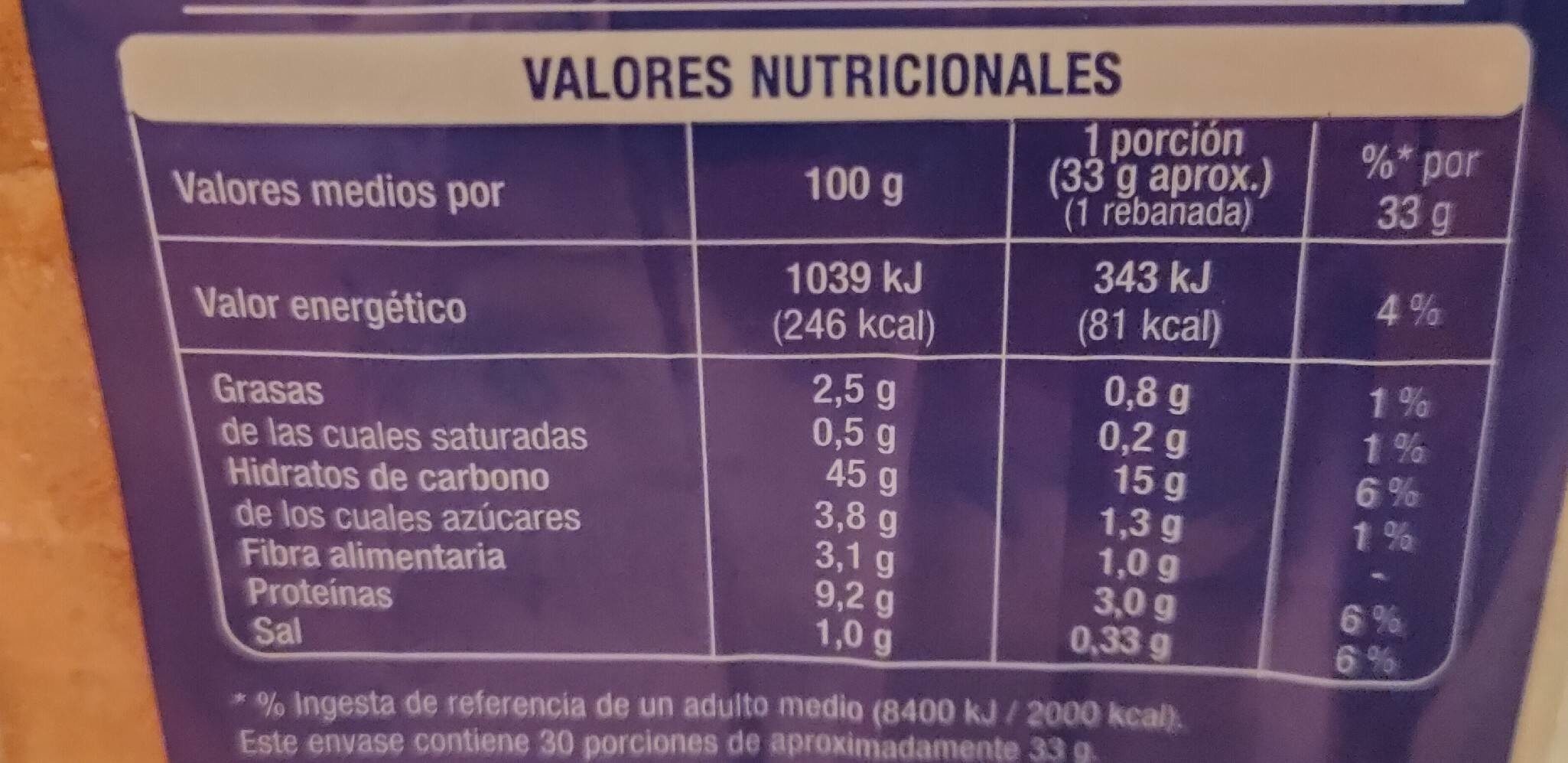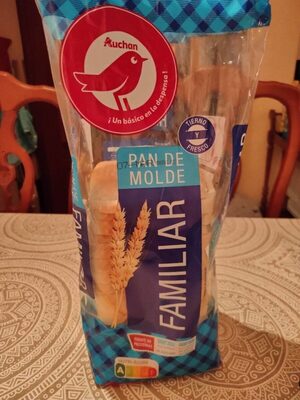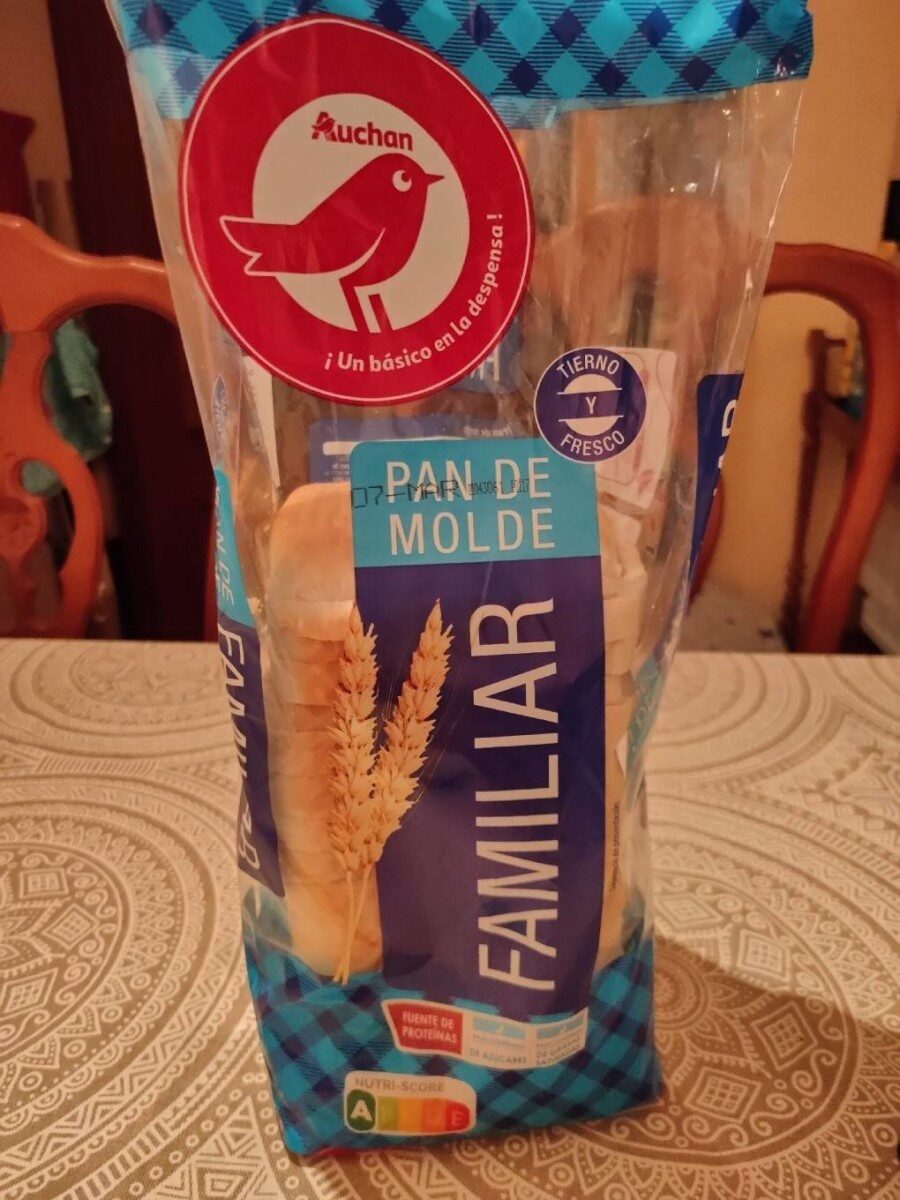Ajuda'ns a fer que la transparència alimentària sigui la norma!
Com a organització sense ànim de lucre, depenem de les vostres donacions per continuar informant els consumidors de tot el món sobre tot allò què mengen.
La revolució alimentària comença amb tu!
Pan de molde - Auchan - 1 kg
Pan de molde - Auchan - 1 kg
Aquesta pàgina del producte no està completa. Podeu ajudar a completar-la editant-la i afegint-hi més dades a partir de les fotos ja disponibles, o fent-ne més amb l'aplicació de androide o iPhone / iPad. Gràcies!
×
Codi de barres: 8423519011039 (EAN / EAN-13)
Quantitat: 1 kg
Empaquetament: Plàstic
Marques: Auchan
Categories: Aliments i begudes amb base vegetal, Aliments amb base vegetal, Cereals i patates, Pans, Pa de motlle
Etiquetes, certificacions, premis: Comptador Nutricional, Grau A Nutriscore
Botigues: Alcampo, Simply, Auchan
Països on es va vendre: Espanya
Matching with your preferences
Salut
Ingredients
-
23 ingredients
: Harina de trigo (67%), agua, levadura, aceite de girasol, sal, azúcar, conservadores (E-282, E-200, E-202), emulgentes (E-472e, E-471, E-481), harina de haba, gluten de trigo (0,2%), corrector de acidez (E-270), fibra de trigo (0,1%), agentes de tratamiento de la harina (E300, E-920, E-341)Al·lèrgens: en:GlutenRastres: en:Sesame seeds, en:Soybeans
Processament d'aliments
-
Aliments ultra processats
Elements que indiquen que el producte està al grup 4 - Aliments i begudes ultraprocessats:
- Additiu: E471 - Monoglicèrids i diglicèrids d'àcids grassos
- Additiu: E472e - Èsters monoacetil i diacetil tartàrics de monoglicèrids i diglicèrids d'àcids grassos
- Additiu: E481 - Estearoïl-2-lactilat de sodi
- Ingredient: Emulsionant
- Ingredient: Gluten
Els productes alimentaris es classifiquen en 4 grups segons el seu grau de processament:
- Aliments no processats o mínimament processats
- Ingredients culinaris processats
- Aliments processats
- Aliments ultra processats
La determinació del grup es fa en funció de la categoria del producte i dels ingredients que conté.
Additius
-
E200 - Àcid sòrbic
Sorbic acid: Sorbic acid, or 2‚4-hexadienoic acid, is a natural organic compound used as a food preservative. It has the chemical formula CH3-CH-4CO2H. It is a colourless solid that is slightly soluble in water and sublimes readily. It was first isolated from the unripe berries of the Sorbus aucuparia -rowan tree-, hence its name.Origen: Wikipedia (Anglès)
-
E202 - Sorbat de potassi
Potassium sorbate: Potassium sorbate is the potassium salt of sorbic acid, chemical formula CH3CH=CH−CH=CH−CO2K. It is a white salt that is very soluble in water -58.2% at 20 °C-. It is primarily used as a food preservative -E number 202-. Potassium sorbate is effective in a variety of applications including food, wine, and personal-care products. While sorbic acid is naturally occurring in some berries, virtually all of the world's production of sorbic acid, from which potassium sorbate is derived, is manufactured synthetically.Origen: Wikipedia (Anglès)
-
E270 - Àcid làctic
Lactic acid: Lactic acid is an organic compound with the formula CH3CH-OH-COOH. In its solid state, it is white and water-soluble. In its liquid state, it is colorless. It is produced both naturally and synthetically. With a hydroxyl group adjacent to the carboxyl group, lactic acid is classified as an alpha-hydroxy acid -AHA-. In the form of its conjugate base called lactate, it plays a role in several biochemical processes. In solution, it can ionize a proton from the carboxyl group, producing the lactate ion CH3CH-OH-CO−2. Compared to acetic acid, its pKa is 1 unit less, meaning lactic acid deprotonates ten times more easily than acetic acid does. This higher acidity is the consequence of the intramolecular hydrogen bonding between the α-hydroxyl and the carboxylate group. Lactic acid is chiral, consisting of two optical isomers. One is known as L--+--lactic acid or -S--lactic acid and the other, its mirror image, is D--−--lactic acid or -R--lactic acid. A mixture of the two in equal amounts is called DL-lactic acid, or racemic lactic acid. Lactic acid is hygroscopic. DL-lactic acid is miscible with water and with ethanol above its melting point which is around 17 or 18 °C. D-lactic acid and L-lactic acid have a higher melting point. In animals, L-lactate is constantly produced from pyruvate via the enzyme lactate dehydrogenase -LDH- in a process of fermentation during normal metabolism and exercise. It does not increase in concentration until the rate of lactate production exceeds the rate of lactate removal, which is governed by a number of factors, including monocarboxylate transporters, concentration and isoform of LDH, and oxidative capacity of tissues. The concentration of blood lactate is usually 1–2 mM at rest, but can rise to over 20 mM during intense exertion and as high as 25 mM afterward. In addition to other biological roles, L-lactic acid is the primary endogenous agonist of hydroxycarboxylic acid receptor 1 -HCA1-, which is a Gi/o-coupled G protein-coupled receptor -GPCR-.In industry, lactic acid fermentation is performed by lactic acid bacteria, which convert simple carbohydrates such as glucose, sucrose, or galactose to lactic acid. These bacteria can also grow in the mouth; the acid they produce is responsible for the tooth decay known as caries. In medicine, lactate is one of the main components of lactated Ringer's solution and Hartmann's solution. These intravenous fluids consist of sodium and potassium cations along with lactate and chloride anions in solution with distilled water, generally in concentrations isotonic with human blood. It is most commonly used for fluid resuscitation after blood loss due to trauma, surgery, or burns.Origen: Wikipedia (Anglès)
-
E282 - Propanoat de calci
Calcium propanoate: Calcium propanoate or calcium propionate has the formula Ca-C2H5COO-2. It is the calcium salt of propanoic acid.Origen: Wikipedia (Anglès)
-
E341 - Fosfat de calci
Calcium phosphate: Calcium phosphate is a family of materials and minerals containing calcium ions -Ca2+- together with inorganic phosphate anions. Some so-called calcium phosphates contain oxide and hydroxide as well. They are white solids of nutritious value.Origen: Wikipedia (Anglès)
-
E471 - Monoglicèrids i diglicèrids d'àcids grassos
Mono- and diglycerides of fatty acids: Mono- and diglycerides of fatty acids -E471- refers to a food additive composed of diglycerides and monoglycerides which is used as an emulsifier. This mixture is also sometimes referred to as partial glycerides.Origen: Wikipedia (Anglès)
-
E481 - Estearoïl-2-lactilat de sodi
Sodium stearoyl lactylate: Sodium stearoyl-2-lactylate -sodium stearoyl lactylate or SSL- is a versatile, FDA approved food additive used to improve the mix tolerance and volume of processed foods. It is one type of a commercially available lactylate. SSL is non-toxic, biodegradable, and typically manufactured using biorenewable feedstocks. Because SSL is a safe and highly effective food additive, it is used in a wide variety of products ranging from baked goods and desserts to pet foods.As described by the Food Chemicals Codex 7th edition, SSL is a cream-colored powder or brittle solid. SSL is currently manufactured by the esterification of stearic acid with lactic acid and partially neutralized with either food-grade soda ash -sodium carbonate- or caustic soda -concentrated sodium hydroxide-. Commercial grade SSL is a mixture of sodium salts of stearoyl lactylic acids and minor proportions of other sodium salts of related acids. The HLB for SSL is 10-12. SSL is slightly hygroscopic, soluble in ethanol and in hot oil or fat, and dispersible in warm water. These properties are the reason that SSL is an excellent emulsifier for fat-in-water emulsions and can also function as a humectant.Origen: Wikipedia (Anglès)
-
E920 - L-cisteïna
Cysteine: Cysteine -symbol Cys or C; - is a semi-essential proteinogenic amino acid with the formula HO2CCH-NH2-CH2SH. The thiol side chain in cysteine often participates in enzymatic reactions, as a nucleophile. The thiol is susceptible to oxidation to give the disulfide derivative cystine, which serves an important structural role in many proteins. When used as a food additive, it has the E number E920. It is encoded by the codons UGU and UGC. Cysteine has the same structure as serine, but with one of its oxygen atoms replaced by sulfur; replacing it with selenium gives selenocysteine. -Like other natural proteinogenic amino acids cysteine has -L- chirality in the older D/L notation based on homology to D and L glyceraldehyde. In the newer R/S system of designating chirality, based on the atomic numbers of atoms near the asymmetric carbon, cysteine -and selenocysteine- have R chirality, because of the presence of sulfur -resp. selenium- as a second neighbor to the asymmetric carbon. The remaining chiral amino acids, having lighter atoms in that position, have S chirality.-Origen: Wikipedia (Anglès)
Anàlisi dels ingredients
-
Pot contenir oli de palma
Ingredients que poden contenir oli de palma: E472e, E471, E481
-
Pot ser vegà
Ingredients que potser no són vegans: E472e, E471, E481, E920
-
Pot ser vegetarià
Ingredients que potser no són vegetarians: E472e, E471, E481, E920
-
Detalls de l'anàlisi dels ingredients
: Harina de trigo 67%, agua, levadura, aceite de girasol, sal, azúcar, conservadores (e282, e200, e202), emulgentes (e472e, e471, e481), harina de haba, gluten de trigo 0.2%, corrector de acidez (e270), fibra de trigo 0.1%, agentes de tratamiento de la harina (e300, e920, e341)- Harina de trigo -> en:wheat-flour - vegan: yes - vegetarian: yes - ciqual_proxy_food_code: 9410 - percent_min: 67 - percent: 67 - percent_max: 67
- agua -> en:water - vegan: yes - vegetarian: yes - ciqual_food_code: 18066 - percent_min: 2.75 - percent_max: 31.2
- levadura -> en:yeast - vegan: yes - vegetarian: yes - percent_min: 0.2 - percent_max: 28.65
- aceite de girasol -> en:sunflower-oil - vegan: yes - vegetarian: yes - from_palm_oil: no - ciqual_food_code: 17440 - percent_min: 0.2 - percent_max: 15.125
- sal -> en:salt - vegan: yes - vegetarian: yes - ciqual_food_code: 11058 - percent_min: 0.2 - percent_max: 1
- azúcar -> en:sugar - vegan: yes - vegetarian: yes - ciqual_proxy_food_code: 31016 - percent_min: 0.2 - percent_max: 1
- conservadores -> en:preservative - percent_min: 0.2 - percent_max: 1
- e282 -> en:e282 - vegan: yes - vegetarian: yes - percent_min: 0 - percent_max: 1
- e200 -> en:e200 - vegan: yes - vegetarian: yes - percent_min: 0 - percent_max: 0.5
- e202 -> en:e202 - vegan: yes - vegetarian: yes - percent_min: 0 - percent_max: 0.333333333333333
- emulgentes -> en:emulsifier - percent_min: 0.2 - percent_max: 1
- e472e -> en:e472e - vegan: maybe - vegetarian: maybe - from_palm_oil: maybe - percent_min: 0 - percent_max: 1
- e471 -> en:e471 - vegan: maybe - vegetarian: maybe - from_palm_oil: maybe - percent_min: 0 - percent_max: 0.5
- e481 -> en:e481 - vegan: maybe - vegetarian: maybe - from_palm_oil: maybe - percent_min: 0 - percent_max: 0.333333333333333
- harina de haba -> en:broad-bean-flour - vegan: yes - vegetarian: yes - ciqual_proxy_food_code: 9410 - percent_min: 0.2 - percent_max: 1
- gluten de trigo -> en:wheat-gluten - vegan: yes - vegetarian: yes - percent_min: 0.2 - percent: 0.2 - percent_max: 0.2
- corrector de acidez -> en:acidity-regulator - percent_min: 0.1 - percent_max: 0.2
- e270 -> en:e270 - vegan: yes - vegetarian: yes - percent_min: 0 - percent_max: 0.2
- fibra de trigo -> en:wheat-fiber - vegan: yes - vegetarian: yes - percent_min: 0.1 - percent: 0.1 - percent_max: 0.1
- agentes de tratamiento de la harina -> en:flour-treatment-agent - percent_min: 0 - percent_max: 0.1
- e300 -> en:e300 - vegan: yes - vegetarian: yes - percent_min: 0 - percent_max: 0.1
- e920 -> en:e920 - vegan: maybe - vegetarian: maybe - percent_min: 0 - percent_max: 0.1
- e341 -> en:e341 - vegan: yes - vegetarian: yes - percent_min: 0 - percent_max: 0.1
Nutrició
-
Molt bona qualitat nutricional
⚠ ️Atenció: la quantitat de fruita, verdura i fruits secs no s'especifica a l'etiqueta, s'ha fet una estimació a partir de la llista d'ingredients: 0Aquest producte no es considera una beguda per al càlcul de la Nutri-Score.
Punts positius: 8
- Proteïnes: 5 / 5 (valor: 9.2, valor arrodonit: 9.2)
- Fibra: 3 / 5 (valor: 3.1, valor arrodonit: 3.1)
- Fruites, verdures, fruits secs i olis de colza/nou/oliva: 0 / 5 (valor: 0, valor arrodonit: 0)
Punts negatius: 7
- Energia: 3 / 10 (valor: 1039, valor arrodonit: 1039)
- Sucres: 0 / 10 (valor: 3.8, valor arrodonit: 3.8)
- Greixos saturats: 0 / 10 (valor: 0.5, valor arrodonit: 0.5)
- Sodi: 4 / 10 (valor: 400, valor arrodonit: 400)
Els punts per proteïnes es compten perquè els punts negatius són inferiors a 11.
Puntuació nutricional: (7 - 8)
Nutri-Score:
-
Nivells de nutrients
-
Greix en baixa quantitat (2.5%)
Què us cal saber- Un alt consum de greixos, especialment de greixos saturats, pot augmentar el colesterol, que augmenta el risc de patir malalties del cor.
Recomanació: Reduïu el consum de greixos i greixos saturats- Trieu productes amb menys greixos i greixos saturats.
-
Àcid gras saturat en baixa quantitat (0.5%)
Què us cal saber- Un alt consum de greixos, especialment de greixos saturats, pot augmentar el colesterol, que augmenta el risc de patir malalties del cor.
Recomanació: Reduïu el consum de greixos i greixos saturats- Trieu productes amb menys greixos i greixos saturats.
-
Sucre en baixa quantitat (3.8%)
Què us cal saber- Un alt consum de sucre pot provocar augment de pes i càries dental. També augmenta el risc de patir diabetis tipus 2 i malalties cardiovasculars.
Recomanació: Limitau el consum de sucre i de begudes ensucrades- Les begudes ensucrades (com ara refrescos, begudes de fruites i sucs i nèctars de fruites) s'han de limitar tant com sigui possible (no més d'1 got al dia).
- Triau productes amb menor contingut de sucre i reduïu el consum de productes amb sucres afegits.
-
Sal comuna en Quantitat moderada (1%)
Què us cal saber- Un alt consum de sal (o sodi) pot provocar un augment de la pressió arterial, que pot augmentar el risc de patir malalties del cor i ictus.
- Moltes persones que tenen hipertensió no ho saben, ja que sovint no en tenen símptomes.
- La majoria de la gent consumeix massa sal (de 9 a 12 grams de mitjana al dia), al voltant del doble del nivell màxim d'ingesta recomanat.
Recomanació: Limitau la ingesta de sal i d'aliments rics en sal- Reduïu la sal que emprau quan cuinau, i no afegiu sal a taula.
- Limiteu el consum d'aperitius salats i trieu productes amb menor contingut de sal.
-
-
Informació nutricional
Informació nutricional Com es ven
per 100 g/100 mlComparat amb: Pa de motlle Energia 1.039 kj
(246 kcal)-4% Greix 2,5 g -34% Àcid gras saturat 0,5 g -29% Hidrats de carboni 45 g +2% Sucre 3,8 g +4% Fiber 3,1 g -40% Proteïna 9,2 g -1% Sal comuna 1 g -11% Fruits‚ vegetables‚ nuts and rapeseed‚ walnut and olive oils (estimate from ingredients list analysis) 0 %
Entorn
-
Eco-puntuació B - Impacte ambiental baix
El Eco-Score és una puntuació experimental que resumeix els impactes ambientals dels productes alimentaris.→ L'Eco-Score es va desenvolupar inicialment a França i s'està ampliant per a altres països europeus. La fórmula Eco-Score està subjecta a canvis, ja que es millora periòdicament per fer-la més precisa i més adequada per a cada país.Anàlisi del cicle de vida
-
Impacte mitjà dels productes de la mateixa categoria: A (Score: 90/100)
Categoria: Sandwich loaf
Categoria: Sandwich loaf
- Puntuació ambiental PEF ( petjada ambiental de l'aliment ): 0.19 (com més baixa sigui la puntuació, menor serà l'impacte)
- incloent l'impacte sobre el canvi climàtic: 1.76 kg CO₂ eq/kg del producte
Etapa Impacte Agricultura
58.9 %Processament
23.6 %Empaquetament
12.2 %Transport
4.8 %Distribució
0.4 %Consum
0.0 %
Bonificacions i punts negatius
-
Falta informació sobre l'origen dels ingredients
Punts negatius: -5
⚠ ️ L'origen dels ingredients d'aquest producte no està indicat.
Si estan indicats a l'embalatge, podeu modificar la fitxa del producte i afegir-los.
Si sou el fabricant d'aquest producte, podeu enviar-nos la informació amb la nostra plataforma gratuïta per a productors.
-
Embalatge d'impacte mitjà
Punts negatius: -10
Forma Material Reciclatge Impacte 1 Bag Plàstic Alt
Eco-Score per a aquest producte
-
Impacte per a aquest producte: B (Score: 75/100)
Producte: Pan de molde - Auchan - 1 kg
Puntuació de l'anàlisi del cicle de vida: 90
Suma de bonificacions i punts negatius: -15
Puntuació final: 75/100
-
Petjada de carboni
-
Equivalent a conduir 0.9 km en un cotxe de gasolina
176 g de CO² per cada 100 g de producte
La xifra d'emissions de carboni prové de la base de dades Agribalyse d'ADEME, per a la categoria: Sandwich loaf (Font: Base de dades ADEME Agribalyse)
Etapa Impacte Agricultura
59.3 %Processament
17.8 %Empaquetament
16.0 %Transport
6.7 %Distribució
0.3 %Consum
0.0 %
Empaquetament
-
Embalatge d'impacte mitjà
-
Peces d'embalatge
1 x Bag (Plàstic)
-
Materials d'embalatge
Material % Pes de l'embalatge Pes de l'embalatge per 100 g de producte Plàstic
-
Transport
-
Orígens dels ingredients
Falta informació sobre l'origen dels ingredients
⚠ ️ L'origen dels ingredients d'aquest producte no està indicat.
Si estan indicats a l'embalatge, podeu modificar la fitxa del producte i afegir-los.
Si sou el fabricant d'aquest producte, podeu enviar-nos la informació amb la nostra plataforma gratuïta per a productors.Add the origins of ingredients for this product Add the origins of ingredients for this product
Report a problem
-
Incomplete or incorrect information?
Category, labels, ingredients, allergens, nutritional information, photos etc.
If the information does not match the information on the packaging, please complete or correct it. Open Food Facts is a collaborative database, and every contribution is useful for all.
Fonts de dades
Producte afegit per kiliweb
Última modificació de la pàgina del producte per itsjustruby.
La pàgina del producte, també editada per hungergames, openfoodfacts-contributors, roboto-app, smoothie-app, teolemon, wingmaster, yuka.A45CBd-2Ae8oEN2M9587_SSaD8DrU6ZgCmdcog, yuka.SDVFaEZxSmJxNk1Mc3RnYzRDTHNvOEJLek0rTmRGbnFPc2dySVE9PQ, yuka.YVk5Yk9iNEZvc0l0Z2ZJKzFTcm8ySTFaeklldGVVQ1VMYkFhSVE9PQ, yuka.ZWFzTU5xUWtqZHdYdWZNU294N2ErUFFyeXJXMWNuanFEdFFWSVE9PQ, yuka.sY2b0xO6T85zoF3NwEKvlkttAsHOpheZbgDtn0qW__ecCsD0R4B30LX1bqo, yuka.sY2b0xO6T85zoF3NwEKvlmdcTYTurg_fHjrvlVOG4_WsLqfnMMBu69XHYqo, yuka.sY2b0xO6T85zoF3NwEKvlnVdcPT4vA3Nbh_fwVez6faBHI3MROpLzZnDbKo.

